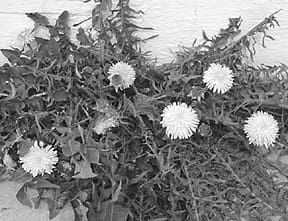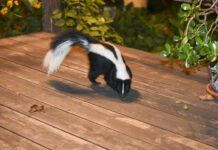[Updated July 19, 2017]
MEDICINAL DANDELION OVERVIEW
– Use dandelion as an adjunct to your dog’s fresh, wholesome, nutritious diet for best effect.
– Grow your own dandelion, and try it yourself!
– If a veterinarian has prescribed a pharmaceutical diuretic for your dog, ask her about slowly replacing the drug with dandelion, under her supervision.
There is no such thing as a stand-alone herb that serves every purpose; each herb in my medicine chest serves as an integral part of an interdependent health care system. However, there is a single herb that persists and flourishes in my memory, just as it does in the fields and gardens where it lives.
I’m not speaking of a rare plant, harvested under the supervision of an aboriginal medicine man from the primordial rainforests of South America. Nor is my favorite herb meticulously farmed in high-tech greenhouses under the scrutiny of horticultural experts. Much to the contrary. The herb I’m talking about is a common, and often-hated weed: Taraxacum officinale, the humble but lovable dandelion.

Dandelion offers a broad spectrum of medicinal and nutritional applications that can be freely accessed and safely employed by anyone. Contained within its leaves, roots, and flowers is a myriad of medicinal actions: diuretic, diaphoretic, cholagogue, alterative, astringent, antimicrobial, analgesic, immunostimulant, and nutritive, just to name a few.
Dandelion’s Long Use in Medicine
A native of Eurasia, dandelion’s use as medicine dates back thousands of years. It was introduced into North America by the earliest of European settlers, who revered dandelion as a “cure-all” tonic that could be propagated quickly and easily to help heal and prevent virtually everything from scurvy to cancer. Not long after its introduction into the New World, knowledge of dandelion’s healing attributes spread throughout many of the Native American nations, and soon the persistent yellow flowers were blooming from coast to coast.
Dandelion became known by physicians as “the official remedy for disorders,” and was incorporated into the U.S. Pharmacopoeia as a broad spectrum tonic and diuretic medicine in 1831. There it remained as an important part of the American pharmacy for nearly 100 years – but eventually, like so many other medicinal plants, dandelion’s mainstream spotlight began to dim with the birth of allopathic “miracle drugs.” Dandelion the wonder herb soon became just another darned weed.
Although it’s largely lost to conventional Western medicine, dandelion remains popular in herbal preparations throughout the world, especially in Europe and Asia. Despite the fact that it’s more versatile than many trendy herbs, dandelion remains relatively obscure in the modern marketplace, perhaps by virtue of its weedy abundance.
Instead of embracing dandelion as a healing ally, society’s collective awareness remains centered on a futile urge to eradicate it, and today dandelion’s greatest contribution to the American economy remains in the sale of herbicide intended to kill it. It’s not being marketed as an “herbal sensation” – after all, why would an herb company spend an advertising fortune to promote a plant that grows from cracks in the sidewalk? Regardless of market appeal, dandelion is one of the first herbs to consider when choosing remedies for your herb cabinet, especially if you intend to gather and process your own medicines.
Dandelion as a Nutritive
To begin an accurate assessment of dandelion’s deep-reaching medicinal attributes, we must first put healing into a whole body perspective.
All higher organisms maintain vital body functions within tightly knit parameters of systemic cooperation. A precise and balanced relationship between nutrition and elimination of waste is a critical part of this cooperation, and if a systemic excess or deficiency occurs that the body cannot correct through elimination, supplementation, or immune system intervention, it will try to compensate by shutting down a system or storing waste materials wherever it can. In other words, a state of “dis-ease” results.
Enter dandelion, one of the most complete plant foods on earth. A one cup serving of fresh dandelion greens will provide as much as 2000 IUs of vitamin A (1½ times the RDA for an adult human); 20 percent protein (double of what spinach provides); vitamins C, K, D, and B-complex; iron; manganese; phosphorus; and many other trace minerals. It’s also a rich source of potassium, which I’ll discuss more below.
All of these vital nutrients are conveniently contained within a single source, in quantities that the body can fully absorb. This means that dandelion will gently supplement the diet without overworking the liver and kidneys with excess vitamins and minerals (this is often signified by dark urine), a problem that sometimes occurs with the use of high-dose vitamin supplements.
Dandelion as a Bitter Tonic
Dandelion leaves also possess what herbalists call a “bitter tonic” principle. Bitter tonics have been well-known for centuries in Europe and Asia, where dandelion and other bitter greens are commonly consumed before a meal to stimulate the secretion of digestive juices (this is how the dinner salad was born). The idea is to “warm up” digestive metabolism before we ask the digestive system to go to work. When a small amount of a bitter herb is taken into the mouth, a sudden increase of salivation occurs. Meanwhile, as the bitter herb reaches the stomach, bile and other digestive agents are triggered into production. This results in less indigestion, better absorption of nutrients, and increased appetite.
The bitter principle is no secret to animals. If you have an opportunity to watch a deer as it begins its day of feeding, you will likely see it nibble at a few bitter plants before turning to the forage it prefers. Even many domesticated dogs and cats nibble bitters when afforded the opportunity.
Bitters are particularly useful in animals who have a chronic problem with indigestion. If your companion has frequent gas and/or passes food that does not appear digested, get him to chew a fresh dandelion leaf, or apply a few drops of dandelion tincture (the type made with glycerin are most palatable) onto his tongue.
Dandelion as a Diuretic
Dandelion is a safe but powerful diuretic and liver stimulant. Diuretics promote urine elimination; normal urination is critical to health. The efficiency of diuresis (the elimination of excess water and systemic waste) can mean the difference between life and death. Congestive heart failure, pulmonary edema, arthritis, gall bladder disease, kidney stone – these are all imbalances resulting from the body’s inability to eliminate water and/or accumulated excesses.
In conventional veterinary practices, drugs such as furosemide (widely known under the brand name “Lasix”) are often used to pull excess fluid from the body and thus promote the elimination of accumulated waste materials. Pharmaceutical diuretics are fast-acting, easy to administer, and very effective, but they tend not to discriminate between what the body needs to keep and what it needs to lose. As a result of pharmaceutical diuretic therapy, the body often loses too much potassium – a crucial heart and brain chemical – through the urinary tract. In this event, potassium must be supplemented throughout the therapy.
Dandelion leaf, in contrast, contains its own rich source of fully assimilable potassium, which helps to replace what would otherwise be lost through urination.
Many contemporary herbalists (including medical researchers, physicians, and veterinarians) claim that when used as a strong tea, dandelion may be as effective as furosemide. And, unlike many other herbal diuretics that work largely by acid-induced kidney irritation, dandelion is very gentle and soothing to the kidneys.
The tradeoff is ease of administration and the time it may take for dandelion to start working. While furosemide can be administered in a little pill, a dandelion therapy involves getting your dog to drink warm tea or take a tincture extract (again, the aforementioned broth method works nicely).
NOTE: If your dog receives conventional pharmaceutical diuretic therapy, see a holistic veterinarian before seeking the dandelion alternative. But on the other hand, there’s no reason why your animal can’t benefit from dandelion’s replacement of potassium while eating it on his meals.
Dandelion is a Liver Tonic, Too
While dandelion’s leaves are very nutritive and diuretic, the root possesses its own usefulness as a safe, reliable liver tonic. The liver is the primary filtering organ of the body, responsible for removing toxins and excesses from the blood for elimination via the kidneys.
The liver also plays critical roles in digestion through its production of bile, bilirubin, and various enzymes. If bile ducts in the liver or gall bladder become congested, blocked, or otherwise diseased to the point of dysfunction, the body will invariably suffer one or more toxicity-related imbalances. Such imbalances may be characterized by symptoms such as jaundice, rheumatoid conditions, eczema, dandruff, or chronic constipation. And while dandelion leaf tea or tincture may help relieve the symptoms of such conditions through a nutritive/diuretic action, the root will work closer to the underlying causes.
Dandelion root has a proven ability to stimulate bile production and circulation throughout the liver. In one study involving dogs (bear in mind that I strongly oppose animal testing), researchers observed a three to four times increase in bile production after administration of dandelion root.
The gallbladder (which stores bile from the liver) is also stimulated, causing this small, hollow organ to contract and release bile into the digestive tract, thus aiding in digestion and acting as a gentle laxative to promote the elimination of solid waste. And in clinical studies using an over-the-counter preparation of the root, dandelion was shown to be effective in treating inflammatory diseases of the liver and gallbladder, including gallstones.
(But please remember: Most of these conditions are preventable, and improper diet is often the underlying cause. Although dandelion has been used successfully in the treatment of liver disease, it is best used at the onset of such conditions; and when adjustments to diet, environment, and the reduction of introduced toxins remains the primary course of therapeutic action. If your animal is in an advanced stage of liver or kidney disease, see your holistic veterinarian for guidance.)
Dandelion for Diabetes
The autumn-harvested root of dandelion is known to contain up to 40 percent inulin, a concentrated dietary fiber that is comprised chiefly of the carbohydrate (sugar) fructose. Inulin is easily assimilated by diabetics, and there is ample evidence to suggest it possesses insulin-like properties that may serve, at least to a limited degree, as an insulin substitute in insulin-dependent diabetic people and their animals.
Additionally, the fructose likely helps to maintain blood sugar levels, while the liver stimulating/diuretic actions of the root improves kidney function and the assimilation of needed nutrients. Many herbalists also believe that dandelion root strengthens pancreatic function; an action that may prove very beneficial in the maintenance of diabetic animals.
More Ways to Use Dandelion
Although not as powerful as goldenseal, dandelion does possess mild infection-fighting qualities and can be used as a gentle, soothing astringent/disinfectant wash. Unlike goldenseal, dandelion isn’t being wiped out in the wild by market demands. A weak decoction (a simmered tea) of dandelion leaves can be diluted in sterile saline (available in the eye care portion of your drugstore) and used as soothing eyewash for conjunctivitis and general eye irritations. Use ¼ teaspoon of the decoction diluted in one ounce of saline; a few drops in the eyes daily should bring relief. The solution will only keep for a few days, so mix it up sparingly.
The roots also have mild immunostimulant qualities – certainly not that of echinacea, but useful as the slight push to the immune system nonetheless. What dandelion lacks in the auto-immune department it makes up for in the form of powerful nutritive qualities. A well-fed body stands strong against infection.
The flowers of dandelion are known by herbalists to be high in lecithin and to have weak but useful analgesic qualities as well.
Identifying and Gathering Dandelion
Dandelion is frequently confused – even by experienced herbalists – with several other species of the sunflower family. And although we may hate to admit it, many of us have been fooled into using one of the look-alikes. The primary consideration to bear in mind when identifying Taraxacum officinale or any of its hundreds of variations is this: Dandelion has no branching characteristics, but instead grows in a rosette fashion, directly off of its taproot. And dandelion never has spines on its midrib, as does Lactuca serriola (“Prickly Lettuce”), which otherwise looks very similar when young. Although dandelion’s impostors likely won’t harm you, they won’t offer you dandelion’s benefits, either.
Gather dandelion greens in early spring for use in salads; they get bitter with age. Leaves intended for herbal teas and medicines can be gathered anytime, provided it is done in dry weather. Wet dandelions tend to develop mold while they are drying, so don’t wash them after picking! Shake them off and dry them on newspapers in a well-ventilated area, away from light. Then stir them often to prevent molding and store them in Zip-Loc bags only after they are completely, crispy dry. Gather the roots as late in fall as possible; this is when they contain the greatest concentration of beneficial constituents. Chop them up (I use a food processor), then spread them onto newspaper and dry with the same consideration you gave to the leaves.
If you wish to propagate dandelion (no, I’m not insane!), give them deep humus-rich soil, full sun, and be moderate with the water if you intend to use them for medicinal purposes. If table fare is your goal, give them lots of water and at least partial shade; this will produce larger, less bitter, tender leaves (but small roots). And you need not be a “closet” dandelion grower; organically farmed dandelion greens are showing up in health food markets and on gourmet menus everywhere. And they often sell for $3 or more per pound!
How to Use Dandelion
The first and foremost consideration in using dandelion as food or medicine is the cleanliness of the plants. Always make sure that the greens you feed have never been sprayed with herbicide. If they have, don’t try washing them; move on to another patch – you won’t have trouble finding more!
Aside from locating a clean source, supplementing your dog’s diet with dandelion is as simple as crumbling the dried greens onto his food. If that doesn’t work, or if you need to get nutrients into your animal more quickly, try making a leaf tea using organic, unsalted vegetable or meat broth in place of plain water. Plan on feeding your dog about a teaspoon of the dried herb for each 20 pounds of his body weight each day. If your companion is sensitive to changes in diet, then start him off with a little at a time.
When feeding dandelions to your dog, don’t forget yourself; dried dandelion greens can be used in place of parsley flakes, and the young fresh greens add a delicious bitter contrast to tossed salads. Try them with lemon.
A Safe Holistic Starting Point
Dandelion is “generally regarded as safe” by the FDA, and aside from any plant allergies, no toxicity or contraindications have been noted relative to its reasonable use.
All of what dandelion offers us plays directly into the entire scheme of what herbal medicines do best. Dandelion does not override the body’s functions, it gently assists them. When we use dandelion, we are not approaching the issues of nutrition and healing from a symptomatic approach (such as when we use dandruff shampoo for a symptom of liver dysfunction); we are addressing the whole body and what it needs to effectively heal itself. In short, dandelion is a very good whole body tonic.
In holistic healing, the first and foremost goal is to reestablish a state of harmonious balance within the body. To do this, everything must function as smoothly as possible. If the body is preoccupied with its duties to a congested liver, overworked kidneys, and a clogged, inefficient digestive tract, it cannot delegate enough healing energy elsewhere. Dandelion can help balance the body’s attention to these tasks. This plant is a persistent and forgiving ally that remains everywhere for us and our animal companions, just waiting to re-emerge as the guardian angel it truly is, despite everything we throw at it.
Greg Tilford serves as a consultant and formulator to hundreds of holistic veterinarians throughout the world, and is CEO of Animal’s Apawthecary, a company that develops herbal products specifically for use in animals.





